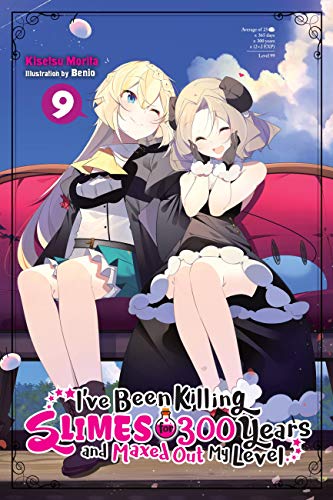By Kisetsu Morita and Benio. Released in Japan as “Slime Taoshite 300 Nen, Shiranai Uchi ni Level MAX ni Nattemashita” by GA Novels. Released in North America by Yen On. Translated by Jasmine Bernhardt.
One of the main reasons to read this series, aside from the fact that it’s a relaxing read where you can be reasonably assured that nothing terrible will be happening to anyone ever, is the push-pull characterization of the lead character, Azusa was an OL in Japan, and she’s subsequently been living for… well, over 300 years by now… in a fantasy world. And yet, of course, for the most part she does not remotely act her age, because her mental state has remained in as much of an unchanging mode as her physical one. This allows for plots where she can be a bit doofy and cute, as well as the main role that she normally fills in the series, which is being a tsukkomi to everyone else. The best parts of this book are where we got to see an Azusa who’s not constantly making comebacks. That said, for those who love that, no fear, the book is still littered with examples.
Stories we see here: Azusa and company help Nintan to help get her followers back by figuring out what’s really driving the current mood; everyone goes to another world created by Godly Goddess and finds out what it’s like to be a slime in a world of slimes; Azusa gets a haircut that ends up being too short, and takes the opportunity to be “big sis” rather than “mom” with her daughters; she and the gang go to a “meat festival” which is basically a barbecue, then watch a bullfight with minotaurs which is EXACTLY like sumo; Azusa and her daughters visit the Great Slime and learn that a 3rd slime similar to them has been born… but she’s reluctant to make Azusa her new mom; and Sandra grows a mushroom hat after a big storm and learns the value of not getting too greedy. Meanwhile, Halkara’s spinoff exists.
The weak point of the book, as you may have guessed, is the Halkara spinoff chapters, which show no signs of getting a series like Beelzebub anytime soon. I like Halkara, but these prequel chapters simply aren’t very good. I’m also a little tired of Azusa having to say that she’s not gay at least once per volume – I get the sense the author knows there’s a large yuri fandom that follows this series and is unhappy about it. (Given the series has only women in it, I’m not sure what they expected.) Other than that, though, this is a pleasant enough book. Azusa’s reaction to her new “daughter” was quite amusing, and the constant comebacks in the bullfight were quite appropriate. The book does seem to really be leaning hard into Japanese culture once more – see the sumo, but also earlier, where a kanji pun has to be explained with the actual kanji for it to work. The translation is excellent, but the original makes for headaches, I expect.
It’s hard to write reviews for series like this, because there’s never going to be anything ever happening beyond the addition of new eccentric characters. But if you want something akin to Nisekoi or Laid-Back Camp, this fits the bill very well.



